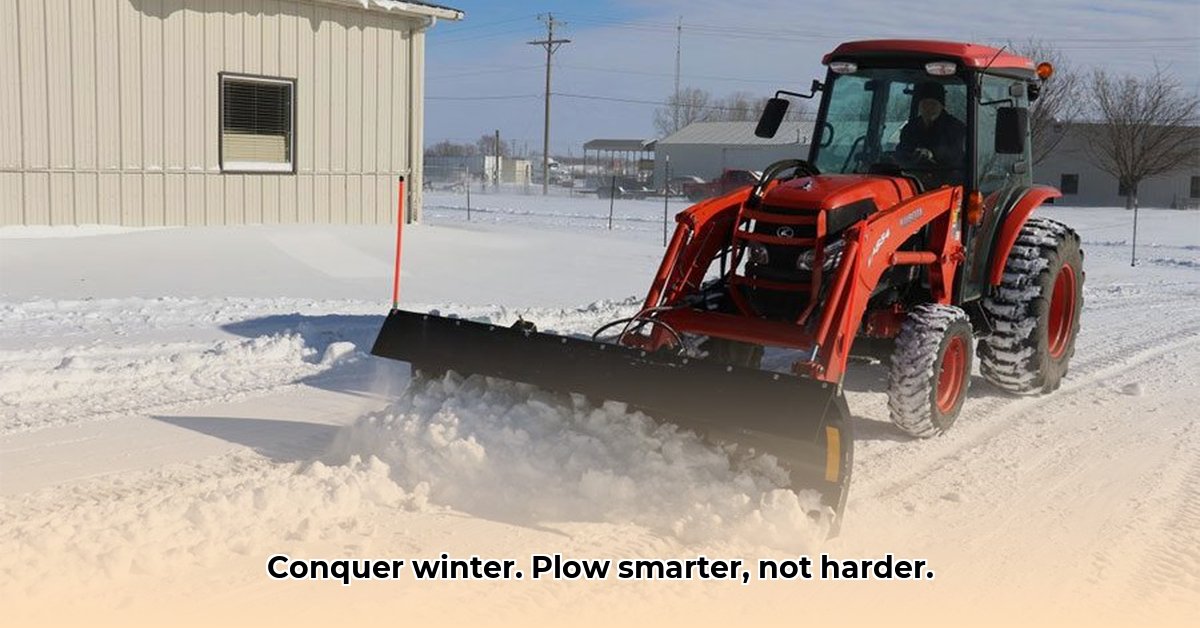
Choosing the Right Tractor Snow Plow
Selecting the ideal tractor snow plow is crucial for efficient and safe winter farm operations. Several factors must be considered to ensure the plow matches your specific needs and budget. Don't just focus on the initial purchase price; consider long-term costs such as maintenance and repairs. A poorly chosen plow can lead to inefficiencies, costly repairs, and even safety hazards. What percentage of your farm operations are impacted by winter weather? For more detailed information, see this helpful guide on tractor snow plow attachments.
Key Considerations:
Budget: Determine your maximum budget, encompassing initial cost, maintenance, and potential repairs. Explore financing options if necessary.
Snowfall: Assess your typical annual snowfall. Heavier snowfall necessitates a more robust plow capable of handling larger snow volumes. How many inches of snow do you typically receive annually?
Tractor Compatibility: Verify the plow's compatibility with your tractor's horsepower and lifting capacity. Consult your tractor's owner's manual to avoid overloading and potential damage.
Farm Size and Terrain: Larger farms with complex terrain require more powerful and versatile plows. What is the size and topography of your farm?
Plow Types: Different plow types excel in various conditions:
- Straight Blades: Suitable for clearing straight paths.
- V-Plows: Efficient for moving large snow volumes.
- Box Plows: Ideal for heavy, wet snow.
Brands: Research reputable brands like Western and Earth & Turf, comparing features, warranties, parts availability, and customer reviews. What brands are readily available and serviced in your area?
Installation and Operation: A Step-by-Step Guide
Safe and efficient snow removal requires meticulous attention to detail. Always prioritize safety by adhering to the following steps:
Preparation: Park your tractor on a level surface, engage the parking brake, and thoroughly review both the tractor's and snow plow's manuals.
Attachment: Carefully align the plow with your tractor's three-point hitch, securing it with pins. Ensure proper alignment before proceeding.
Hydraulic Connection (if applicable): Securely connect hydraulic lines, ensuring a tight seal to prevent leaks.
Testing: Raise and lower the plow to confirm proper hydraulic function and angle adjustment.
Operation: Start slowly, gradually increasing speed as you gain confidence. Adjust the plow's angle as needed. Avoid abrupt movements and maintain control.
Detachment: Lower the plow completely before detaching it, following the manufacturer's instructions.
Maintenance and Troubleshooting: Proactive Care
Regular maintenance is essential for optimal performance and longevity. Neglecting maintenance can lead to costly repairs and downtime. What is your current maintenance schedule for farm equipment?
Routine Maintenance:
Regular Checks: Frequently check hydraulic fluid levels and follow the manufacturer's recommendations for fluid changes.
Inspection: Inspect bolts, pins, and welds for wear and tear. Address any issues promptly.
Lubrication: Lubricate moving parts as recommended by the manufacturer; this helps prevent corrosion and ensures smooth operation.
Troubleshooting: Consult your owner's manual or contact the manufacturer for assistance with any issues. Addressing minor problems early prevents them from escalating.
Environmental Considerations and Long-Term Costs
While snow plows significantly improve farm efficiency, their environmental impact must be considered. Fuel consumption and soil compaction are key areas of concern. How can you minimize the environmental impact of your snow removal practices?
Mitigation Strategies:
Biofuels: Consider using biofuels to reduce greenhouse gas emissions.
Efficient Techniques: Optimize plowing routes and techniques to minimize passes and soil disturbance.
Long-Term Costs: Factor in fuel, maintenance, repairs, and potential upgrades over the plow's lifespan. Calculate the return on investment.
Government Assistance: Explore available grants or subsidies for sustainable farming practices.
Comparing Tractor Snow Plow Options: A Detailed Analysis
Choosing between different brands requires careful comparison. This table provides a general comparison; always conduct thorough research about specific models.
| Feature | Western Plow | Earth & Turf Plow | Considerations |
|---|---|---|---|
| Price | Typically higher | Often more affordable | Balance initial cost with long-term maintenance |
| Durability | Generally very durable | Typically robust | Evaluate needs; heavy-duty might not be necessary |
| Ease of Use | User-friendly designs | User-friendly designs; check specific model reviews | Choose familiar design |
| Quick Attach | Usually included | Usually included | Quick-attach saves significant time |
Remember, the best snow plow depends on your individual needs and circumstances. Thorough research and careful planning are key to making a sound investment.